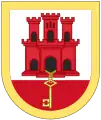 |
|---|
|
|
| History of Gibraltar |
|---|
 |
| Timeline |
|
|
The Gibraltar Constitution Order 1969 was published on 30 May 1969 as an Order in Council.
The constitution was the outcome of the Constitutional Conference chaired by Malcolm Shepherd, 2nd Baron Shepherd which lasted from 16 July to 24 July 1968. The Gibraltarian members of the Constitutional Conference were: Joshua Hassan, Aurelio Montegriffo and Abraham Serfaty for the Association for the Advancement of Civil Rights; Robert Peliza, Maurice Xiberras and legal advisor Sir Frederick Bennet for the Integration With Britain Party; and Peter Isola.[1]
Development
The move towards the 1969 Constitution was sparked off after the outcome of the 1967 sovereignty referendum, where 99.19% of Gibraltarians voted against passing under Spanish sovereignty and in favour of retaining their link with Britain, with democratic local institutions and with Britain retaining its present responsibilities.
Preamble

The crucial feature of the 1969 constitution for the Gibraltarians was the preamble to the Order in Council promulgating the Constitution, in its final form began:
Whereas Gibraltar is part of Her Majesty’s dominions and Her Majesty’s Government have given assurances to the people of Gibraltar that Gibraltar will remain part of Her Majesty’s dominions unless and until an Act of Parliament otherwise provides, and furthermore that Her Majesty’s Government will never enter into arrangements under which the people of Gibraltar would pass under the sovereignty of another state against their freely and democratically expressed wishes.
This preamble has been called the "single most significant statement made on the sovereignty of Gibraltar since the signing of the Treaty of Utrecht".[2]
Frontier closure
Upon the request of the United Nations, Spain and the United Kingdom had been developing inconclusive talks about Gibraltar for the previous three years. Since 1954, the Government of Spain under the leadership of Francisco Franco had been applying increasingly restrictive measures in its relationships with Gibraltar. On 24 July 1968, it complained to the UN Secretary General claiming that the constitutional talks were a "further obstacle to the solution of Gibraltar's future", a statement that was rejected by the Government of the United Kingdom.[2] On 20 May 1968[3] the Gibraltar–Spain border was closed by the Spanish Guardia Civil and chaos ensued as controls were implemented on travellers trying to use the ferry service at the port of Algeciras. This situation (which lasted into September 1968) was a precursor to the frontier closure implemented the following year.
The Constitution was published on 30 May 1969 and came into immediate effect. Elections were scheduled for 30 July. The Spanish government described the promulgation as an open disregard by the UK government of the UN Resolutions and a violation of the Treaty of Utrecht. On 6 July 1969, the decision to close the land border between Spain and Gibraltar was taken. Next day the decision was implemented.[4]
The closing of the border, together with various other restrictions, was a severe shock for the Gibraltarians, who became aware that across the frontier there was a hostile and threatening foreign power. The closure of the frontier would last thirteen years and was considered by the Gibraltarians as the last in a series of sieges held by Spain to attempt to secure the surrender of the town.
See also
Sources
- Jackson, William (1990). The Rock of the Gibraltarians. A History of Gibraltar (2nd ed.). Grendon, Northamptonshire, UK: Gibraltar Books. p. 316. ISBN 0-948466-14-6.
References
- ↑ The Gibraltar Constitution - 1969
- 1 2 Peter Gold (2005). Gibraltar: British or Spanish?. Routledge. p. 19. ISBN 0-415-34795-5.
- ↑ Winston Ramsey, ed. (1978). "Gibraltar". After the Battle. No. 21. p. 3. ISSN 0306-154X.
- ↑ Peter Gold (2005). Gibraltar: British or Spanish?. Routledge. p. 21. ISBN 0-415-34795-5.
.svg.png.webp)